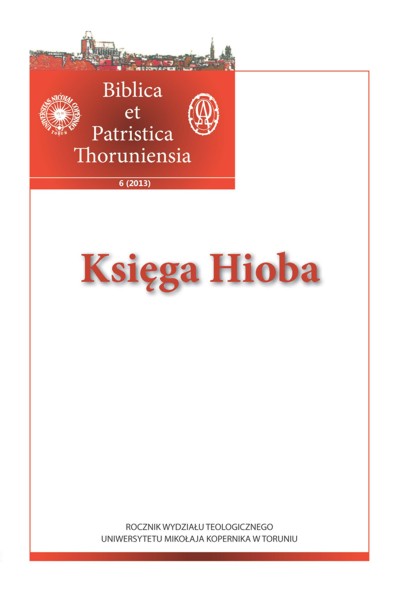"L'ira dell’Agnello" nell'Apocalisse di san Giovanni (6,16–17)
DOI:
https://doi.org/10.12775/BPTh.2013.012Słowa kluczowe
Ap 6, 6-17, Baranek, gniew, Bóg, Chrystus, zbawienie, krzyż, apokaliptykaAbstrakt
„Gniew Baranka” w Apokalipsie św. Jana (6,16–17)
Przedmiotem niniejszego studium była perykopa wyjęta z Księgi Apokalipsy św. Jana zatytułowana "Otwarcie szóstej pieczęci" (Ap 6,12-17). W ramach tej sekcji literackiej wnikliwej analizie egzegetyczno-literackiej poddany został fragment, który zamyka wspomnianą perykopę, mówiącego o "gniewie Baranka" (Ap 6,16-17). Biorąc pod uwagę prezentację Baranka w tekście Ap 5,6-10 oraz uwzględniając wszystkie wiadomości zawarte w początkowej doksologii, która prezentuje Jezusa Chrystusa jako tego, który „... nas miłuje i który przez swą krew uwolnił nas od naszych grzechów” (Ap 1,5), bardzo dziwną i obcą jawi się ta figura pełna gniewu i wzburzenia.
Analiza egzegetyczna wyrażania „gniew Baranka” (Ap 6,16-17) pozwala jednak dostrzec w Baranku nie tylko postać głoszącą niewinność i słodycz, lecz również pewien złożony symbol, a mówiąc językiem Apokalipsy całkowitą liczbę, która zawiera w sobie pełnię całego dzieła zbawczego Jezusa Chrystusa. W sekcji pieczęci, poczynając od tekstu Ap 6,1, Baranek jawi się jako postać bardzo aktywna w historii, która wywołuje i kieruje wydarzeniami kosmicznymi, dzięki swojej potędze i sile. Zjawiska te są rozpoczynają cały łańcuch zdarzeń, które obwieszczają początek ostatecznego sądu nad światem. W ich kontekście Baranek pojawia się jako wielki sędzia, który umarł a jednak zmartwychwstał i żyje. Jest on napełniony mocą Bożą i pełnia Ducha św. Jemu też w chwili sądu zostaje dana ta sama moc i chwała jak przysługuje Wszechmogącemu, który zasiada na tronie. Obraz Branka, który wyłania się z tekstu „otwarcia szóstej pieczęci”, a szczególnie ze słów jej zakończenia (Ap 6,16-17) ukazuje Go jako równego Bogu zwłaszcza w wykonywaniu sądu nad światem. Tę moc i władzę sądzenia Baranek zdobył przez swoją śmierć na krzyżu i sprawuje ją w sposób absolutny.
Chrystus-Baranek jako władca wszystkich książąt i królów ziemi (Ap 1,5) sprawuje sąd, który jest jednocześnie gniewem wobec tych, którzy Go odrzucili. Wielki gniew Baranka, który tak bardzo przeraża i poraża ludzi stojących wobec Niego w opozycji, nie jest jednak integralną częścią Jego natury, lecz jako taki jawi się tym, którzy uwierzyli bestii i poddali się, zgodnie z dalszą relacją Księgi Apokalipsy św. (Ap 13), władzy zła. Kłamstwo i zbrodnia stały się drugą naturą tych, którzy odrzucili dzieło zbawcze Chrystusa dokonane na krzyżu. W konfrontacji z nieskończonym źródłem miłości, które wypływa z dobrowolnej ofiary Baranka, nie są w stanie zauważyć w Nim nic poza Jego gniewem i straszliwą zemstą. Stąd lepiej jest dla nich skryć się pod górami (Ap 6,16-17), aniżeli spojrzeć w Jego zbawcze oblicze.
Bibliografia
Bauckham R., “The earthquake in the Apocalypse of John”, NT 19 (1977), s. 220-235.
Caird G. B., Revelation of the St. John, (London 1984).
Fallon M., The Apocalypse as revelation that history is graced, (Estwood 1990) 63; J. Roloff, Die Offenbarung des Johannes, (Zürich 1984).
Giesen H., „Symbole und mythische Aussagen in der Johannesapokalypse“, QD 126 (1988).
Hohnjec N., Das Lamm-to, avrni,on in der Offenbarung des Johannes. Eine exegetischteologische Untersuchung, (Roma 1980).
Holtz T., Die Christologie der Apocalypse des Johannes, (Göttingen 1962).
Prigent P., L’Apocalisse di S. Giovanni, (Roma 1982)
Roloff J., Die Offenbarung des Johannes, (ZBK NT 18; Zürich).
Schüssler Fiorenza E., Apocalisse. Visione di un mondo giusto, (Brescia 1994).
Swete H. B., The Apocalypse of St.John, (London 1907).
van Ruiten J., „Der Alttestamentliche Hintergrund von Ap 6,12–17“, EstBib 53 (1995), s. 238-249.
Vanni U., L’Apocalisse. Ermeneutica, esegesi, teologia, (Bologna 1988).
Vögtle A., Das neue Testament und die Zukunft des Kosmos, (Düsseldorf 1970).
Whale P., „The Lamb of John. Some Myths about of the Johannine Literature”, JBL 106 (1987), s. 289-295.
Wilk J., „Triumf Baranka jako przewodnia idea Apokalipsy”, CT 40 (1970), s. 41-58.
Pobrania
Opublikowane
Jak cytować
Numer
Dział
Licencja
CC BY ND 4.0. Posiadaczem prawa autorskiego (Licencjodawcą) jest Autor, który na mocy umowy licencyjnej udziela nieodpłatnie prawa do eksploatacji dzieła na polach wskazanych w umowie.
- Licencjodawca udziela Licencjobiorcy licencji niewyłącznej na korzystanie z Utworu/przedmiotu prawa pokrewnego w następujących polach eksploatacji: a) utrwalanie Utworu/przedmiotu prawa pokrewnego; b) reprodukowanie (zwielokrotnienie) Utworu/przedmiotu prawa pokrewnego drukiem i techniką cyfrową (e-book, audiobook); c) wprowadzania do obrotu egzemplarzy zwielokrotnionego Utworu/przedmiotu prawa pokrewnego; d) wprowadzenie Utworu/przedmiotu prawa pokrewnego do pamięci komputera; e) rozpowszechnianie utworu w wersji elektronicznej w formule open access na licencji Creative Commons (CC BY-ND 3.0) poprzez platformę cyfrową Wydawnictwa Naukowego UMK oraz repozytorium UMK.
- Korzystanie przez Licencjobiorcę z utrwalonego Utworu ww. polach nie jest ograniczone czasowo ilościowo i terytorialnie.
- Licencjodawca udziela Licencjobiorcy licencji do Utworu/przedmiotu prawa pokrewnego nieodpłatnie na czas nieokreślony
PEŁEN TEKST UMOWY LICENCYJNEJ >>
Statystyki
Liczba wyświetleń i pobrań: 720
Liczba cytowań: 0



